7 Sensory and Motor Systems
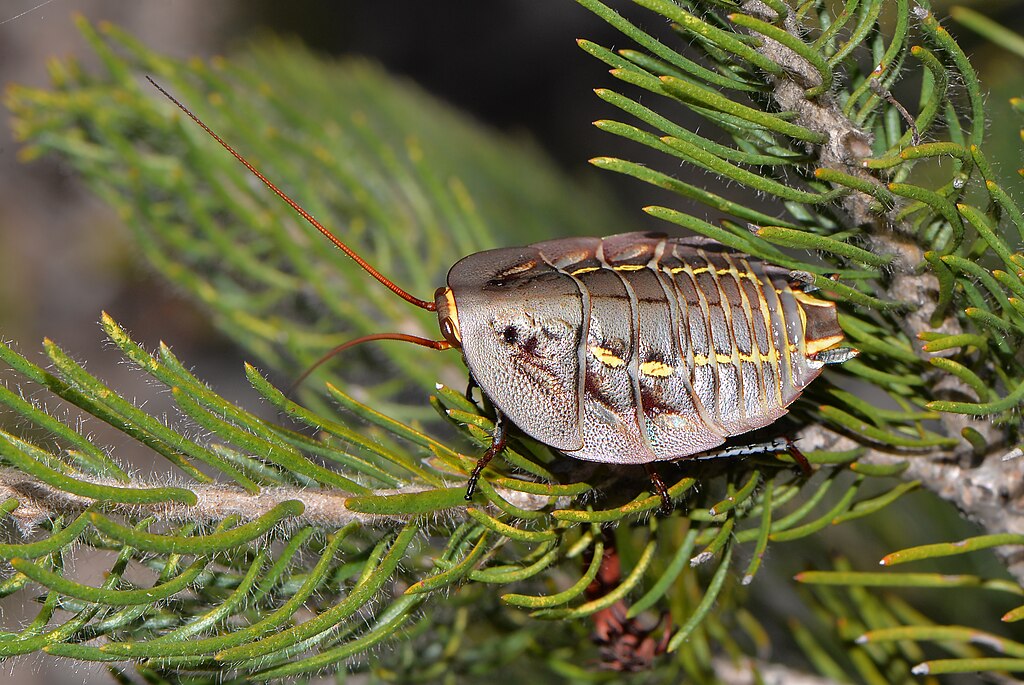
For relatively simple organisms, insects can carry out some incredibly complex flight manoeuvres. We begin to explore the way insects regulate such complex behaviours. First, we see how insects sense external stimuli through the cuticle, then we examine the organisation of the central nervous system. Finally we touch on some of the complexities of insect locomotion.
Learning Objectives
- the diversity of sense organs possessed by insects
- the role of the central nervous system in integrating sensory input and regulating motor output
- how insects have evolved an auditory sense based on the ability of chordotonal organs to detect vibration
SensorI-Motor Systems
THRD0023 021 (YouTube, 3m 41s):
A key to success of insects, mentioned in topic 1, is the ability to fly and the possession of a sophisticated sensori-motor system. Here we will explore the diversity of insect senses, the structure of the sense organs and the way sensory and musculature systems combine to permit sophisticated flight and walking control.
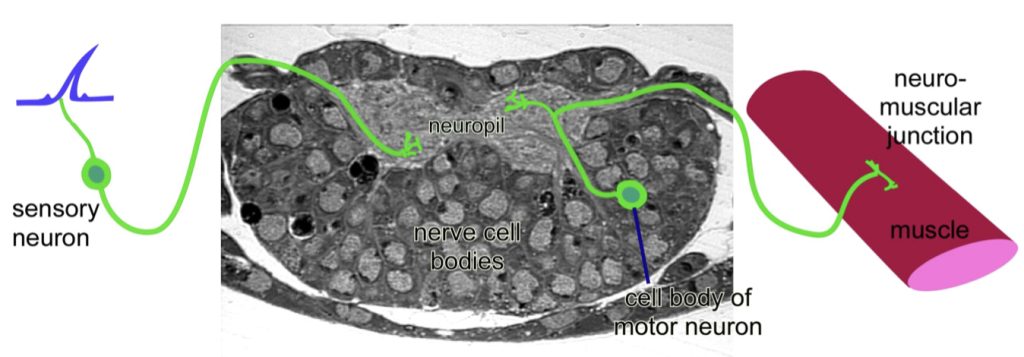
Insect sense organs tend to be concentrated into areas that specialise in sensory perception. The head with the eyes, antennae and mouthparts is one such area. Other sense organs can be found concentrated on the legs, wings and general body surface. Sense organs are usually situated on the cuticle because this is where the stimuli are encountered. The cell bodies of sensory neurons sit immediately under the sense organ itself and their axons run along nerves into the central nervous system (CNS).
Central Nervous System (CNS)
The insect central nervous system is composed of a string of segmental units called ganglia. The brain is a fusion of multiple ganglia, located in the head.
The original pattern of ganglia in the ancestral state was probably one ganglion per segment with an ancient fusion of ganglia to form the brain. Commonly in insects, the thoracic ganglia are fused, probably to speed up neural signalling over shorter distances allowing the complex integration of sensory and motor information needed for the regulation of flight and walking. There are different degrees of fusion of ganglia in different groups, indicating that there is a groundplan for each group. In the Diptera, each family seems to have the same degree and type of fusion.
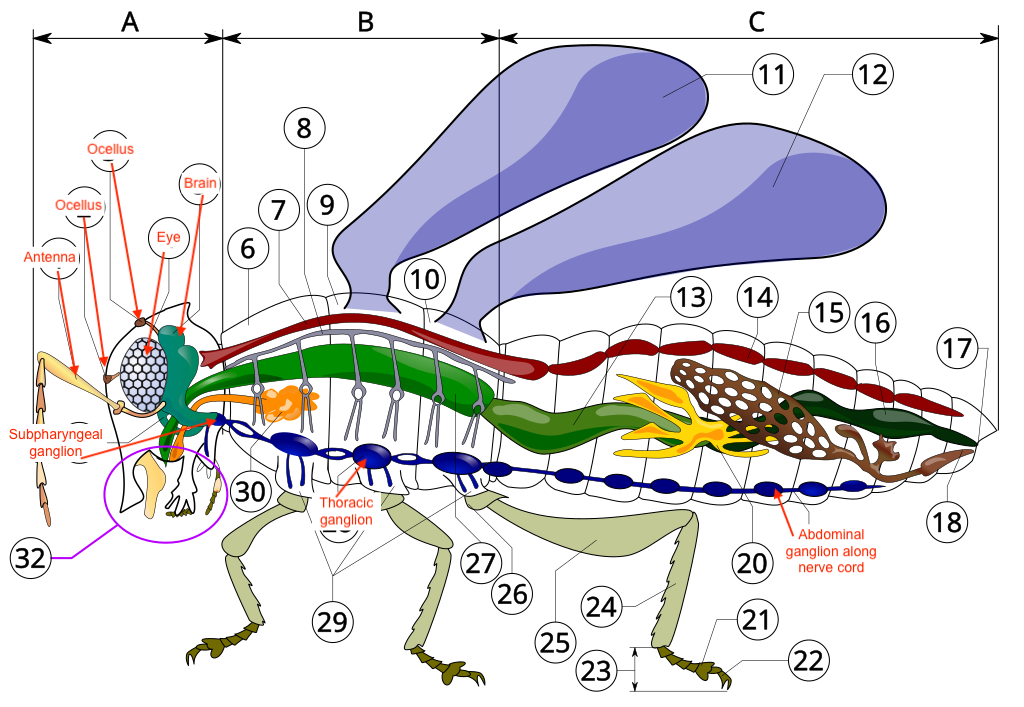
Much of the brain is taken up with neuropil associated with integration of sensory information: the optic lobes (vision) and the olfactory glomeruli (olfaction).
| Types of senses | sense organs | location |
|---|---|---|
| vision | eyes, ommatidia, stemmata, ocelli | head |
| touch | tactile hairs, campaniform sensilla | all over the body; concentrated on legs |
| taste | gustatory hairs and pegs | mouthparts, wings, ovipositor |
| smell | olfactory sensilla | antennae |
| hearing | chordotonal organs | Johnston’s organ, other locations |
| nociception (injurious stimuli) | multidendritic neurons | side of body wall |
| heat and cold | various hair-like sensilla and some internal multidendritic neurons | antennae |
Vision
THRD0023 022 (YouTube, 4m 37s):
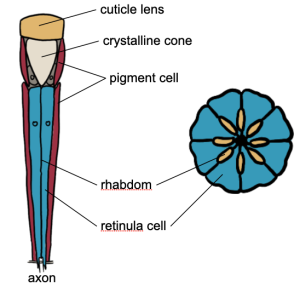
Note that flying insects usually have sophisticated vision. The compound eyes are made up of many individual ommatidia, clustered together in a highly structured hexagonal matrix. The outermost cuticle is transparent, allowing light to penetrate inward into the light-receiving (photoreceptive) cells, called retinular cells or photoreceptor cells. Each ommatidium has 7 of these sensory neurons.
Compound eyes are found in adults and nymphs. They are the major organs of sight. They focus light and consequently form images.
Ocelli are found in adults and nymphs. Most adult insects have a cluster of ocelli between the compound eyes. They do not focus light and cannot form images; however, they are very sensitive to changes in light intensity.

Stemmata are common in holometabolous larvae, e.g. caterpillars.
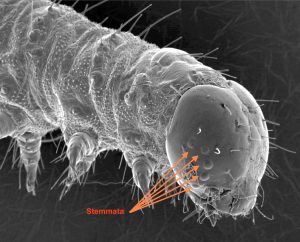
Colour
The colour range sensitivity of insects is shifted to shorter wavelengths than in humans. Most insects don’t see red very well at all and most insects are sensitive to ultraviolet light.
The general inability of insects to see red can be used to our advantage. If you wanted to do experiments on insects, for example, watch their behaviour at night, you can illuminate the experiment with dim, red light and the insects behave as if they are in total darkness, while an observer can see what is going on. The trouble is, a few insects have been shown to be red-sensitive, so you cannot assume all insects are red-blind.
One way around this is to use the fact that many video cameras are sensitive to near infra-red (NIR) light. Neither we nor insects can see near infra-red, but if you illuminate a scene with NIR (NIR LED illuminators are readily available) a video camera registers a near-normal, grey-scale image.
Sensilla (= Sense Organs)
A functional classification of sensilla is not coincident with a classification based on anatomy of the receptors. Functionally, sensilla of various morphological types have been shown to respond to different categories of stimuli.
Sensilla are broadly classed as:
- chemoreceptors (taste and olfaction)
- thermoreceptors
- mechanoreceptors.
Each sensillum has from one to many sensory neurons associated with it. The nerve cell body sends an axon into the CNS. Opposite to the axon, a sensory dendrite emerges from the nerve cell body. It is associated with the cuticle of the sensillum. The dendrite may be branched (especially olfactory sensilla) or unbranched (taste receptors and mechano-receptors).
Antennae are probably the most important sensory structures in the majority of insects in terms of variety and functions of sensory receptors. Antenna are usually covered with thousands of individual olfactory sensilla. Taste receptors are often present as well, especially in insects with long antennae that are used to tap the substrate. Antennal olfactory receptors are used in tracking odour plumes, for example, a blowfly attracted to carrion, or a male moth tracking the pheromone plume released by a female.
Olfaction
Olfactory sensilla have many pores in the wall of the sense organ. The sense organs can vary in external appearance from long hairs, to short pegs, to flattened domes. The olfactory dendrites are finely branched to increase surface area. The walls of the cuticular peg or hair have many fine pores allowing molecules to enter and access the walls of the dendrites.
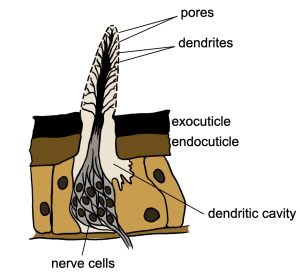
Touch
THRD0023 023 (YouTube, 3m 46s):
Touch receptors are spread all over the body. They inform the insect when it is touching something and provide feedback on limb position; for example, during grooming. Sensory receptors within the limbs also provide feedback on the relative positions of the leg segments during walking. They are concentrated near the joints and are termed proprioceptors. The key attributes are that touch-receptors have a single neuron per sense organ. The single neuron has a single dendrite whose tip is compressed as hair moves, firing an electrical signal that runs along the axon into the CNS.
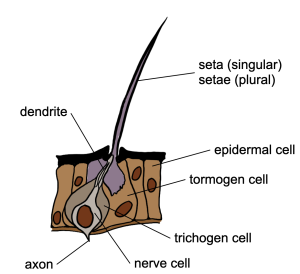
Hearing
Insects hear by detecting the vibration of parts of their body in reaction to sound. There is no one type of ear common to all insects. Auditory sensitivity has evolved many times separately, usually based around a site where there is a concentration of a type of proprioceptor called a chordotonal sensillum. The most common type of ear is located in the Johnston’s organ in the pedicel of the antennae. In simple terms, the sound causes the antenna to vibrate which is detected by the chordotonal organs in the pedicel.
Key attributes of chordotonal organs are that they are capable of detecting subtle movements. The movement detection can be proprioceptive (giving feedback on position) or auditory (detecting vibration). Clusters of many chordotonal sense organs provide range sensitivity. The dendrite tip is kept under tension by surrounding cells.
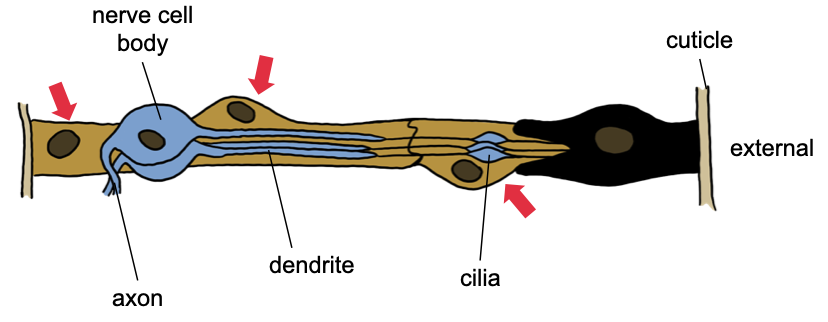
Other examples
- Johnston’s organ as an auditory receptor.
- A circle of chordotonal organs lie in the pedicel of many insects’ antennae. The flagellomeres (elements of the flagellum) vibrate in response to sound. The ring of chordotonal organs detects the vibration and transmits its characteristics into the brain via the sensory axons.
- Tympanum-based auditory perception in Orthoptera (see activity)
- Tympanum-based auditory perception in parasitoid flies.
Keen to know more? Check out: caterpillars sensing parasitoid wasps via “electroreception”
Taste receptors
THRD0023 024 (YouTube, 2m 50s):
Gustatory sensilla are located in large numbers on the mouthparts. They are also concentrated on the tarsi and, in some insects, on the wings. A characteristic of gustatory sensilla is that they usually have multiple sensory neurons per sensillum and each sensory neuron responds to a different suite of stimuli. The stimuli reach the dendrites via a pore at the tip of the hair or peg.
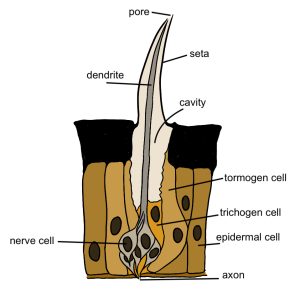
The Motor System
The muscles of insects are elongated and multicellular. They tend to be pinkish in colour. Motor neurons synapse onto the muscles at sites called neuromuscular junctions.
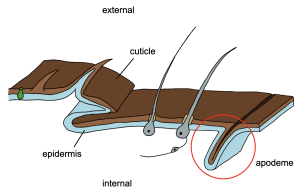
The big difference between vertebrates and arthropods is that in arthropods the muscles involved in locomotion and movement insert on the inside of the cuticle. They have special muscle attachment sites, called tonofibrillae. Frequently the cuticle grows inwards at the site of muscle attachment to form an apodeme or apophysis.
•apodeme: an inner, cuticular ridge
•apophysis: an elongate inward cuticular extension
The biggest muscle blocks are in the thorax in the form of the flight muscles.
Insects Flying
One role of the eyes in flight control is to provide feedback on flight speed. The rate of movement of the visual field across the compound eye tells the insect how fast it is moving. Flight stability relies on inputs from the eyes and from sensory receptors that detect airflow.
In flies, the halteres act as gyroscopes, oscillating at the same frequency as the wings but out-of-phase. Removal of the halteres causes flies to crash!
In butterflies and moths, the chordotonal organs at the base of the antenna (Johnston’s organ) have the same role.
Insects walking
Insects use a stable gait based on usually having 3 legs on the surface at any one time, while the other 3 legs are off the ground and moving. A central pattern generator controls this basic walking gait. Robotics researchers have studied the sensory and motor control of walking in insects in the hope of applying the same principles to guiding six-legged robots.
Activities
Activity 7-1
Name the sense organ that an insect would use:
- to detect a person’s footsteps?
- to detect the wind blowing its antenna?
- to detect a weight was on its back?
- to be able to move away from light?
Activity 7-2
Carry out a search of the scientific literature and read about the structure of tympanum-based auditory perception in parasitoid flies and Orthoptera.
Activity 7-3
Go to the external site “How Insects Fly” and become familiar with the content. It takes you on a tour of wing structures, flapping flight, the role of the compound eye in maintaining flight stability and the way insect flight muscles can act directly or indirectly to flap the wings. Read about the indirect and direct flight muscles and how they regulate wing-beat frequency.
Topic Review
Do you know…?
- The names of the main sensillum types and how they differ morphologically?
- The names of the different types of eyes and the stages of insects where they are found in?
Can you…?
- Draw and describe the differences between indirect and direct flight muscle activity?
- Describe what is meant by a tripod gait?

